Warning Letter To Employee
[Your Name]
[Your Job Title/Position]
[Company Name]
[Company Address]
[City, State, ZIP Code]
[Date]
[Employee's Name]
[Employee's Job Title/Position]
[Department Name]
[Company Name]
[Company Address]
[City, State, ZIP Code]
Subject: Formal Warning Letter
Dear [Employee's Name],
I hope this letter finds you well. I am writing to address a serious matter that requires your immediate attention. It has come to our notice that your recent behavior and performance at work have not met the expectations and standards set by our company. This letter serves as an official warning to inform you that your conduct needs to be rectified to avoid further consequences.
The following issues have been observed, which have led to this warning:
1. **Poor Performance:** Your work output has consistently fallen below the required standards. We have noticed a decline in the quality and quantity of your work, which has affected the overall team's productivity and the company's success.
2. **Attendance and Punctuality:** There have been multiple instances of unexplained absences and tardiness, which disrupts the workflow and causes inconvenience to your colleagues and the management.
3. **Lack of Professionalism:** Your behavior in the workplace has not been in line with the company's code of conduct. This includes but is not limited to inappropriate language, unprofessional interactions with colleagues, and a lack of respect for superiors.
As an employee of our company, we expect you to demonstrate professionalism, dedication, and a commitment to excellence. We understand that everyone goes through challenging times, and we are willing to support you in addressing any personal or professional difficulties you may be facing.
In light of the above concerns, we urge you to take the necessary steps to improve your performance and conduct. We expect to see significant progress within [a specific time frame, e.g., 30 days] from the date of this letter.
To assist you in achieving improvement, we recommend the following:
1. **Performance Improvement Plan:** You will be placed on a formal Performance Improvement Plan (PIP). This plan will outline clear performance objectives and the support provided to help you reach them.
2. **Attendance and Punctuality:** Strict adherence to the company's attendance and punctuality policies is mandatory. If you encounter any unforeseen circumstances affecting your attendance, you must promptly inform your supervisor.
3. **Professional Development:** Consider participating in relevant training or workshops to enhance your skills and knowledge in areas that require improvement.
Please note that failure to meet the outlined expectations or any further breaches of company policies may lead to additional disciplinary actions, up to and including termination of employment.
We hope that you will take this warning seriously and work towards making the necessary improvements. Remember that your success is crucial to both your personal growth and the company's prosperity.
If you have any questions or require clarification on any aspect of this warning, do not hesitate to discuss it with your supervisor or the Human Resources department.
We trust in your ability to make the necessary changes and look forward to seeing positive developments in your performance and conduct.
Sincerely,
[Your Name]
[Your Job Title/Position]
[Company Name]
Formal Warning Letter to Employee
Subject: Official Warning Regarding Performance
Dear [Employee Name],
This letter serves as a formal warning regarding your recent performance and conduct issues observed in your role as [Job Title]. Specific areas of concern include [List Specific Issues, e.g., repeated tardiness, missed deadlines, unprofessional behavior].
We expect immediate improvement in these areas. Failure to demonstrate significant progress may lead to further disciplinary action, up to and including termination of employment.
Please acknowledge receipt of this warning and take corrective action accordingly.
Sincerely,
[Supervisor Name]
[Title]
[Company Name]
Casual Warning Message to Employee
Hi [Employee Name],
I want to bring to your attention some concerns regarding [specific behavior or performance]. It’s important that we see improvement in [specific tasks or conduct].
Please treat this as a serious notice and take the necessary steps to address these issues.
Thanks,
[Supervisor Name]
Serious Conduct Warning Letter
Subject: Warning Regarding Workplace Conduct
Dear [Employee Name],
It has been observed that your recent behavior, including [describe behavior], does not comply with company policies. This letter serves as a formal warning, and you are required to correct this behavior immediately.
Further violations may result in more severe disciplinary measures, including termination.
Please review company policies and meet with HR for guidance.
Sincerely,
[HR Manager Name]
[Company Name]
Performance Improvement Warning Letter
Subject: Performance Warning
Dear [Employee Name],
Your performance in [specific project or task] has fallen below expectations. Specific concerns include [list issues, e.g., missed deadlines, low quality work, insufficient collaboration].
You are required to submit a written plan outlining how you will improve. Failure to show progress may result in further disciplinary action.
Sincerely,
[Supervisor Name]
[Title]
[Company Name]
Preliminary Warning Letter
Dear [Employee Name],
This letter is to notify you of preliminary concerns regarding your work performance and/or conduct. This notice serves as a reminder of company standards and expectations.
Please take this warning seriously and implement corrective actions immediately.
Sincerely,
[Supervisor Name]
[Company Name]
Heartfelt Warning Letter
Dear [Employee Name],
We value your contribution to the team; however, there are some concerns regarding your recent [behavior/performance]. It is important for both your growth and the company’s standards that you address these issues.
Please take immediate action to improve. We are here to support you in achieving better results.
Kind regards,
[Supervisor Name]
[Company Name]
Quick Warning Message
Hi [Employee Name],
This is a formal notice regarding concerns about your recent performance/behavior. Please address this immediately.
Thank you,
[Supervisor Name]
What is a Warning Letter to an Employee and Why It Is Needed
- A written notification to an employee about performance or behavior concerns.
- Establishes a formal record for HR and company files.
- Provides clear guidance on areas needing improvement.
- Serves as a precursor to more serious disciplinary action if issues persist.
Who Should Send a Warning Letter to an Employee
- Direct supervisor or manager.
- Human Resources representative for formal warnings.
- Senior management in cases of serious misconduct.
Whom Should a Warning Letter Be Addressed To
- The employee exhibiting performance or conduct issues.
- Include full name, job title, and department.
- If applicable, copy HR for record-keeping.
When to Issue a Warning Letter
- When an employee violates company policies or standards.
- After verbal warnings have not resolved the issue.
- In cases of repeated performance issues, absenteeism, tardiness, or misconduct.
- Prior to escalated disciplinary actions such as suspension or termination.
How to Write and Send a Warning Letter
- Clearly state the subject and reason for the warning.
- List specific incidents, dates, and expectations for improvement.
- Maintain professional, factual, and respectful tone.
- Indicate potential consequences if improvement is not made.
- Send as a printed letter on company letterhead or via official email.
How Many Warning Letters Are Typically Issued
- Usually starts with one formal warning.
- Additional warnings may be issued for repeated violations (second or final warning).
- Each letter should be documented for HR records and employee files.
Requirements and Prerequisites Before Sending a Warning Letter
- Evidence of the issue: emails, attendance records, performance metrics.
- Documentation of prior verbal warnings or discussions.
- Company policies outlining expectations and consequences.
- HR approval if formal letter is issued.
- Clear objective for expected improvements.
Formatting Guidelines for a Warning Letter
- Length: 1 page recommended.
- Tone: professional, serious, or formal.
- Structure: subject, greeting, body detailing issues, required actions, closing.
- Include date, signature, and contact information.
- Use official company letterhead for printed letters.
Common Mistakes to Avoid in a Warning Letter
- Using vague or ambiguous language.
- Failing to provide specific examples of behavior/performance issues.
- Threatening without clear follow-up procedures.
- Sending without HR review or approval.
- Ignoring tone; overly emotional or aggressive language can escalate conflict.
Elements and Structure of a Warning Letter
- Subject line clearly indicating purpose.
- Salutation with employee’s name.
- Description of the issue, with dates and examples.
- Reference to prior discussions or verbal warnings.
- Statement of required improvements or actions.
- Consequences for failing to improve.
- Closing, signature, and date.
- CC to HR if needed.
Tips and Best Practices for Effective Warning Letters
- Be timely: issue warnings soon after incidents occur.
- Be specific: include examples and evidence.
- Maintain professionalism and objectivity.
- Provide clear expectations and deadlines for improvement.
- Keep records of all communications for legal and HR purposes.
Pros and Cons of Issuing a Warning Letter
- Pros:
- Provides official documentation.
- Encourages employee improvement.
- Protects the organization legally.
- Cons:
- May strain employee relations if not handled carefully.
- Can be ignored if not followed up properly.
- May require further HR involvement for escalation.
After Sending a Warning Letter: Follow-up Actions
- Schedule a meeting to discuss the letter and clarify expectations.
- Monitor performance and behavior over the specified improvement period.
- Document improvements or further violations.
- Decide on further action if improvements are not observed.
Does a Warning Letter Require Attestation or Authorization?
- Yes, typically must be signed by the supervisor or manager issuing it.
- HR approval may be required for formal warnings.
- Employee acknowledgment signature is often requested to confirm receipt.


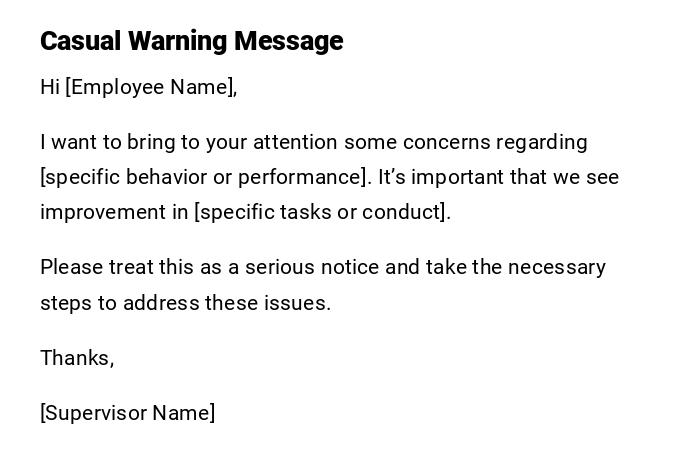
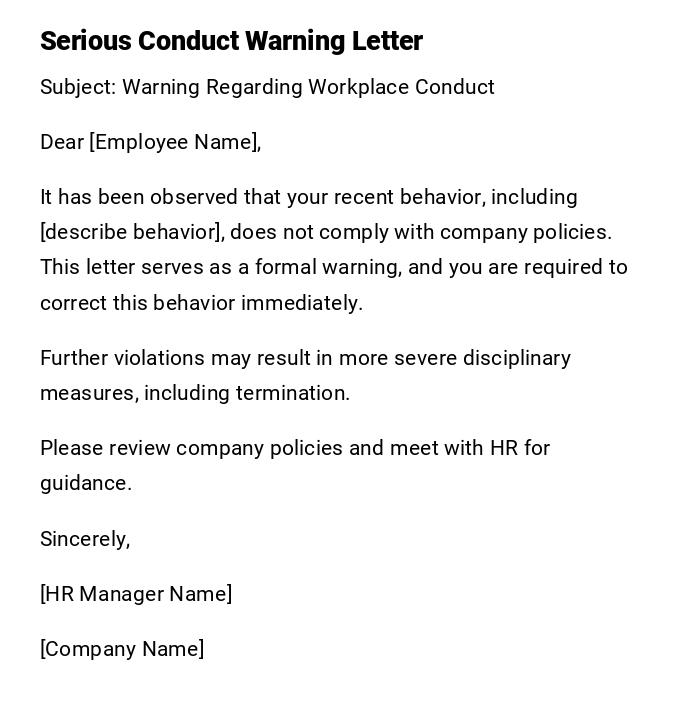
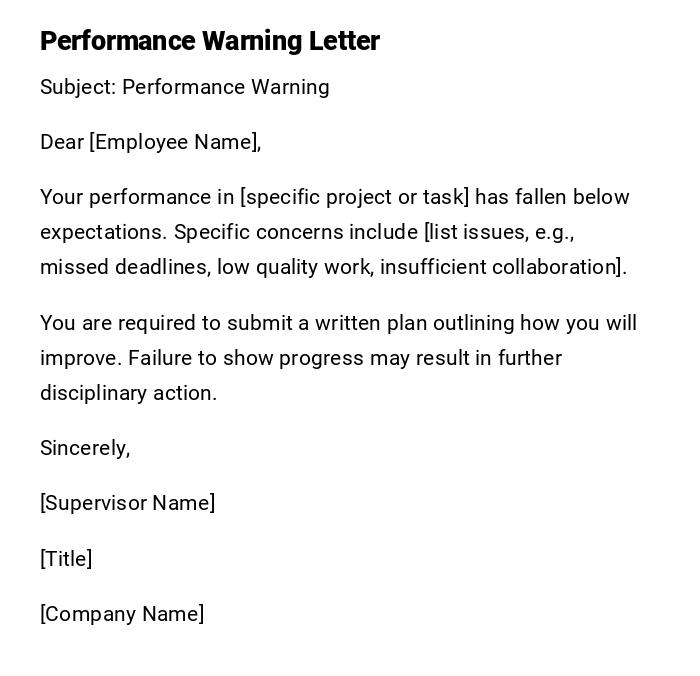

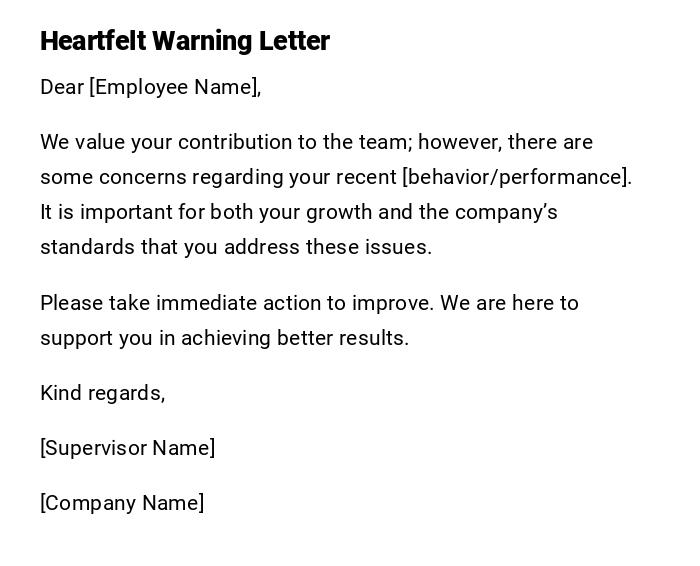
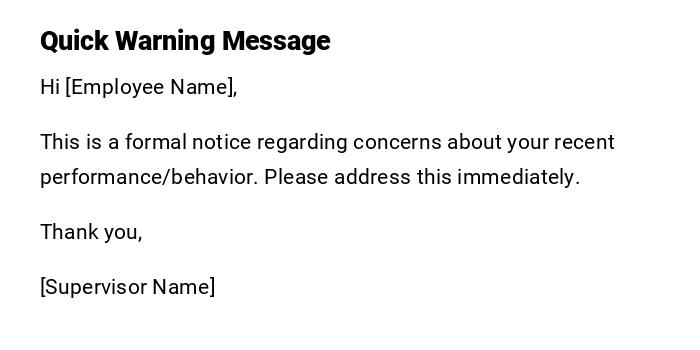

 Download Word Doc
Download Word Doc
 Download PDF
Download PDF